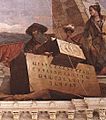Saint Mesrob facts for kids
Quick facts for kids Mesrop Mashtots |
|
|---|---|

Painting by Stepanos Nersisian (1815–84), kept at the Pontifical Residence at the Mother See of Holy Etchmiadzin
|
|
| Born | c. 362 Hatsik, Taron Province, Kingdom of Armenia |
| Died | February 17, 440 Vagharshapat, Armenia |
| Venerated in | Armenian Apostolic Church Armenian Catholic Church Roman Catholic Church Orthodox Church |
| Major shrine | Saint Mesrop Mashtots Cathedral in Oshakan, Armenia |
| Feast | The Armenian Church remembers St. Mesrop (together with St. Sahak), twice each year, first in July and then again on the Feast of the Holy Translators in October; February 17 in the Roman Catholic Church. |
| Patronage | Armenia |
Saint Mesrop Mashtots (born around 360, died February 17, 440) was a very important Armenian monk. He is famous for inventing the Armenian alphabet in the year 406. This was a huge step for Armenia! It helped make the Armenian Church stronger, improved the Armenian government, and connected Armenians living in different empires. Mesrop Mashtots was also a smart thinker and a language expert.
Contents
Who Was Mesrop Mashtots?
Mesrop Mashtots was born in a village called Hatsik, in the Taron Province of the ancient Armenian Kingdom. He grew up to be a very educated person. He knew many languages, including Greek, Syriac, and Persian.
Early Life and Work
Before he became a monk, Mesrop worked for the Armenian king. He was a secretary and helped the king write important documents. He also served as a soldier for a short time. Later, he decided to become a monk and dedicated his life to God. He traveled around Armenia, teaching people about Christianity.
Why an Alphabet Was Needed
During Mesrop's time, Armenians used other languages like Greek and Syriac for writing. This made it hard for people to read the Bible and other important texts in their own language. The Armenian Church wanted its own alphabet. This would help spread Christianity and unite the Armenian people.
Inventing the Armenian Alphabet
Mesrop Mashtots understood how important it was for Armenians to have their own unique writing system. He traveled to different places, studying various alphabets and languages. He worked very hard to create letters that would fit the Armenian language perfectly.
The Birth of the Letters
In 406 AD, after much effort, Mesrop Mashtots finally created the Armenian alphabet. It had 36 letters at first, and later a few more were added. This new alphabet was a huge success! It allowed Armenians to write down their history, their faith, and their culture.
Impact of the Alphabet
The invention of the Armenian alphabet changed everything for Armenia.
- Stronger Church: The Bible and other religious books could now be translated into Armenian. This helped more people understand their faith.
- United Nation: The alphabet helped unite Armenians, no matter where they lived. It gave them a shared identity and a way to communicate.
- Education and Culture: Schools were opened where children learned to read and write in Armenian. This led to a flourishing of Armenian literature, history, and science.
Mesrop's Legacy
Mesrop Mashtots did not stop after creating the alphabet. He also helped create alphabets for other languages, like Georgian and Caucasian Albanian. He spent the rest of his life teaching and translating.
The Holy Translators
Mesrop Mashtots worked closely with other scholars, like Sahak Partev, to translate the Bible into Armenian. These scholars are known as the "Holy Translators" in the Armenian Church. Their work was vital for Armenian culture.
Where He is Remembered
Mesrop Mashtots died in 440 AD. He is buried in the village of Oshakan, Armenia. His grave is a special place where many people visit. There is also a large statue of him in front of the Matenadaran in Yerevan, which is a famous museum of ancient manuscripts.
Mesrop Mashtots is celebrated as a saint in the Armenian Church and other Christian churches. His invention of the Armenian alphabet is one of the most important events in Armenian history. It helped preserve the Armenian language and culture for centuries.
Images for kids
-
Fresco of Mesrop by Giovanni Battista Tiepolo (1696-1770) at the Würzburg Residence in Bavaria
-
The statue of Mesrop Mashtots and Koryun (kneeling) in front of Matenadaran, Yerevan
See also
 In Spanish: Mesrob Mashtots para niños
In Spanish: Mesrob Mashtots para niños








